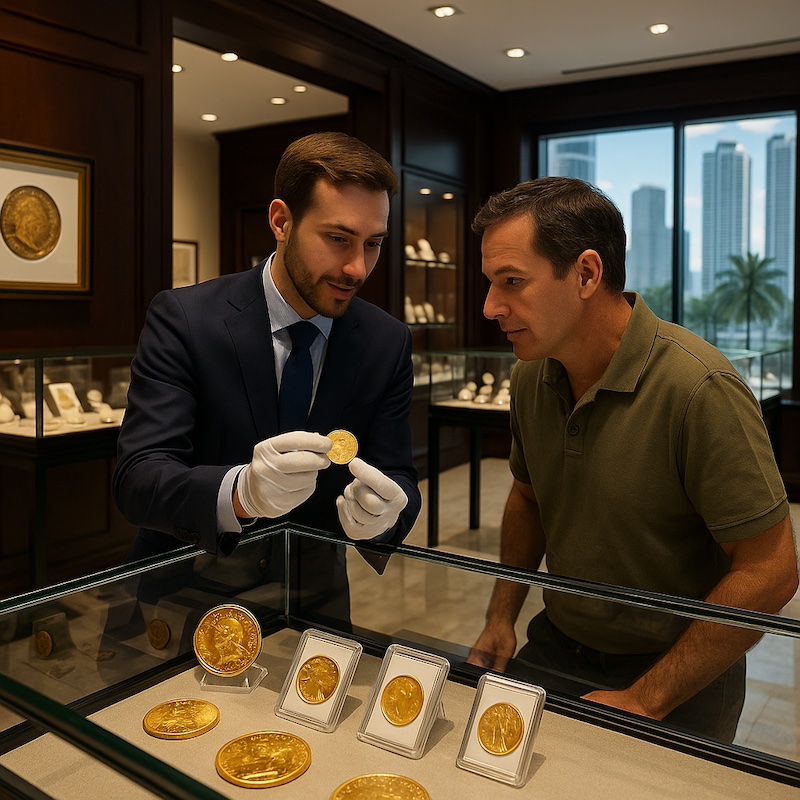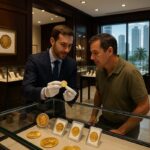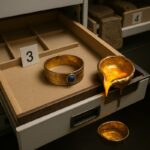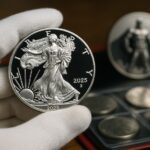Walk into a rare coin gallery with zero numismatic knowledge and walk out a committed coin enthusiast—sounds unlikely, right? Yet that’s exactly what happened to one Miami visitor after an hour inside Stack’s Bowers Galleries’ new Brickell showroom.
For U.S. coin collectors, industry professionals and investors, this story is more than a feel-good anecdote. It illustrates how modern galleries are reshaping the way people discover rare coins, learn the market, and connect with the history behind each piece.
Stack’s Bowers, one of America’s oldest and most respected rare coin auctioneers—tracing its roots back to 1933—recently opened its first Miami coin gallery in the heart of the city’s financial district.
The result is a space that feels part museum, part trading floor, and part story-telling studio. And it’s helping turn casual walk-ins into lifelong numismatists.
TL;DR – Why a Rare Coin Gallery Matters Now
- Stack’s Bowers has opened a new rare coin gallery in Miami’s Brickell neighborhood, expanding its network of U.S. and global locations.
- Galleries like this offer museum-quality displays, on-site experts, and direct access to rare coins, paper money and high-end auctions.
- Iconic pieces such as the 1933 Double Eagle—sold for a record $18.9 million in 2021—show how numismatics intersects with art, history and serious investment capital.
- For new and experienced collectors alike, a rare coin gallery can be a safer, more educational environment than navigating the market alone online.
What Is a Rare Coin Gallery—and Why Now?
A rare coin gallery is more than a shop with coins in cases. It’s a curated environment where:
- museum-caliber rarities are displayed to the public
- numismatists provide on-site expertise and appraisals
- consignors connect their collections to the global auction market
- new collectors can ask questions without pressure
Stack’s Bowers’ Miami gallery, for example, sits on the ground floor of a luxury Brickell high-rise, positioned to serve both U.S. collectors and clients from Central and South America.
This timing isn’t accidental. Miami has rapidly become a key financial hub, drawing wealth from across the Americas, while collectibles—from rare coins to fine art—have gained attention as alternative assets.
For numismatics, that means more potential buyers, more consignments, and a broader audience discovering the hobby for the first time.
Inside a Rare Coin Gallery: Turning Curiosity into Enthusiasm
So what actually happens when you step into a place like Stack’s Bowers’ Miami coin gallery?
A Curated Walk Through History
Visitors can see:
- 19th-century U.S. gold pieces
- early Colombian and Latin American coinage from the 1500s onward
- high-denomination U.S. banknotes such as $500 and $1,000 bills
- modern certified rarities in top-grade holders
One highlighted piece in the original article was an 1858 $3 gold proof, with roughly 15 known survivors—a coin that rarely appears outside high-end auctions or major museum exhibits.
The Power of Story
What truly “hooks” many visitors isn’t just the metal; it’s the narrative. Head numismatists like William Conroy in Miami are essentially historians with a dealer’s eye, weaving:
- political history (revolutions, gold bans, currency reforms)
- human drama (lost collections, smuggled coins, estate discoveries)
- technical details (minting errors, die varieties, grading nuances)
As Conroy notes, “there are so many niches in this industry it’ll blow your mind”—from copper half-cents to first-year type sets and ultra-high-grade “finest known” collections. The industry is “just as personal as people who collect art, cars or anything else.”
That personal angle is often what turns a casual gallery visit into a lifelong rare coin collecting habit.
Rare Coin Gallery Spotlight: The 1933 Double Eagle Story
Nothing illustrates the drama of the numismatic market better than the 1933 Saint-Gaudens Double Eagle.
- Around 445,500 of these $20 gold pieces were struck in 1933. Before they could be released, President Franklin Roosevelt suspended gold convertibility and ordered most gold coins melted.
- A handful escaped destruction. The U.S. government later declared them illegal to own, seizing examples that surfaced and melting many of them.
- One specimen, however, was exported to King Farouk of Egypt under a valid license. Decades later it resurfaced and sold in a 2002 Stack’s/Sotheby’s collaboration for $7.59 million, then again at Sotheby’s in 2021 for $18.9 million, making it the world’s most valuable coin.
Galleries associated with major auction houses are often where such stories are told—and where collectors can see similar ultra-rarities up close. For a new visitor, realizing that a single $20 coin could become a nearly $19 million treasure instantly reframes how they view the coins in their own pocket.
Rare Coin Gallery vs. Traditional Coin Shop
Both have their place, but they serve slightly different roles in the ecosystem.
| Feature | Rare Coin Gallery | Traditional Coin Shop |
|---|---|---|
| Primary focus | High-end rarities, certified coins, major consignments | Broad mix: common coins, bullion, supplies |
| Typical services | Appraisals, auction placement, portfolio consultation | Buy/sell, basic appraisals, hobby supplies |
| Atmosphere | Gallery / museum-like, curated cases | Retail storefront, often more casual |
| Clientele | Advanced collectors, investors, estates | Local hobbyists, beginners, walk-in bullion buyers |
| Connection to auctions | Direct pipeline to global rare coin auctions | May consign, but usually via third parties |
| Educational resources | On-site experts, curated exhibits, event programming | Owner knowledge, occasional club flyers or books |
Stack’s Bowers, for instance, runs regular online and live auctions offering thousands of lots—from U.S. coins to world currency and ancient pieces—giving gallery visitors a direct window into current market pricing and demand. Stack’s Bowers+2pcgs.com+2
Pros and Cons of Using a Rare Coin Gallery
Advantages
- High-quality material – Galleries tied to major auctioneers often handle world-class collections and fresh estate material.
- Professional expertise – Staffed by experienced numismatists who can explain grading, provenance and market trends.
- Transparent pricing – Access to auction archives and real hammer prices makes it easier to benchmark values.
- Security and trust – Reputable firms maintain strong security, insurance and authenticity guarantees.
Potential Drawbacks
- Higher price point – Inventory tends to skew toward mid-to-high value coins; true “bargain bin” material is limited.
- Intimidation factor – New collectors may feel out of place among six-figure coins and institutional buyers.
- Market focus – A rare coin gallery is designed to move significant value; it may not stock every modern type or inexpensive album filler a casual hobbyist wants.
For many collectors, the ideal strategy is a blend: use galleries for education, appraisals and high-end acquisitions, while still enjoying local shows, online marketplaces and traditional shops for day-to-day collecting.
How Coin Collectors and Investors Can Use a Rare Coin Gallery
Whether you’re a seasoned numismatist or a curious visitor, here are practical ways to make the most of a gallery visit:
- Schedule a valuation appointment
- Bring a selection of your better coins or inherited pieces.
- Ask for a verbal opinion on authenticity, relative quality and which items might merit certification or auction consignment.
- Study the display cases
- Note differences between grades on similar types.
- Compare eye appeal, toning, strike and luster.
- Leverage auction archives
- Many firms, including Stack’s Bowers, provide free online archives showing past sale prices. Use these to understand realistic market levels, not just retail lists.
- Ask about collecting niches
- Talk with the staff about specialized areas—early copper, Latin American crowns, proof gold, error coins—and see what fits your interests and budget.
- Clarify fees and terms upfront
- If you’re consigning to auction, understand buyer’s premiums, seller’s commissions, reserves and timing.
Always remember: no gallery visit replaces independent research and, for large financial decisions, advice tailored to your situation. Consider this article educational, not individualized investment advice.
FAQ: Rare Coin Galleries and High-End Collecting
1. Are rare coin galleries only for wealthy investors?
Not at all. While many galleries handle six- and seven-figure coins, most also welcome beginners. Visitors can view museum-quality pieces for free, ask questions, and sometimes buy more affordable certified coins or entry-level rarities.
2. How does a rare coin gallery make money?
Revenue typically comes from:
- commissions on auction consignments
- retail sales of coins and currency
- appraisal and advisory services for collectors, estates and institutions
Because galleries like Stack’s Bowers handle high-value pieces and large collections, a relatively small number of transactions can represent significant business volume. Stack’s Bowers+2coinagemag.com+2
3. Is it safer to buy in a rare coin gallery than online?
Reputable galleries and auction houses generally offer strong authenticity guarantees, established reputations and clear return policies. Online marketplaces can be safe as well—but they tend to vary widely in seller quality. For expensive coins, many collectors prefer the additional security of a gallery or top-tier auction firm.
4. How many coin collectors are there in the U.S.?
Exact numbers are hard to pin down, but survey data suggest that tens of millions of Americans have collected coins at some point, and roughly one to three percent of adults may qualify as collectors by broad definitions. Numismatic News+2blog.money.org+2
5. Can visiting a rare coin gallery really help me learn faster?
Yes. Seeing graded coins in person, talking with professional numismatists, and studying auction-quality material accelerates your learning curve far more than photos alone. It’s like stepping into a live, hands-on textbook of numismatic history.
Conclusion: Your First Step into a Rare Coin Gallery
Miami’s new Stack’s Bowers showroom is just one example of how a rare coin gallery can transform casual curiosity into genuine enthusiasm. By combining world-class rarities, knowledgeable staff and a welcoming environment, galleries bridge the gap between the museum world and the marketplace.
For U.S. coin collectors, industry pros and investors, the takeaway is simple:
- Use galleries as educational hubs and market barometers.
- Ask questions, study the coins, and leverage auction archives to inform your decisions.
- Treat high-value purchases and consignments with the same due diligence you’d apply to any serious financial move.
And if you’re in Miami—or any city with a major numismatic gallery—consider stopping by. You might walk in as a casual visitor and walk out a genuine coin enthusiast.







